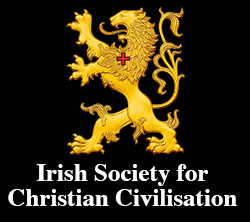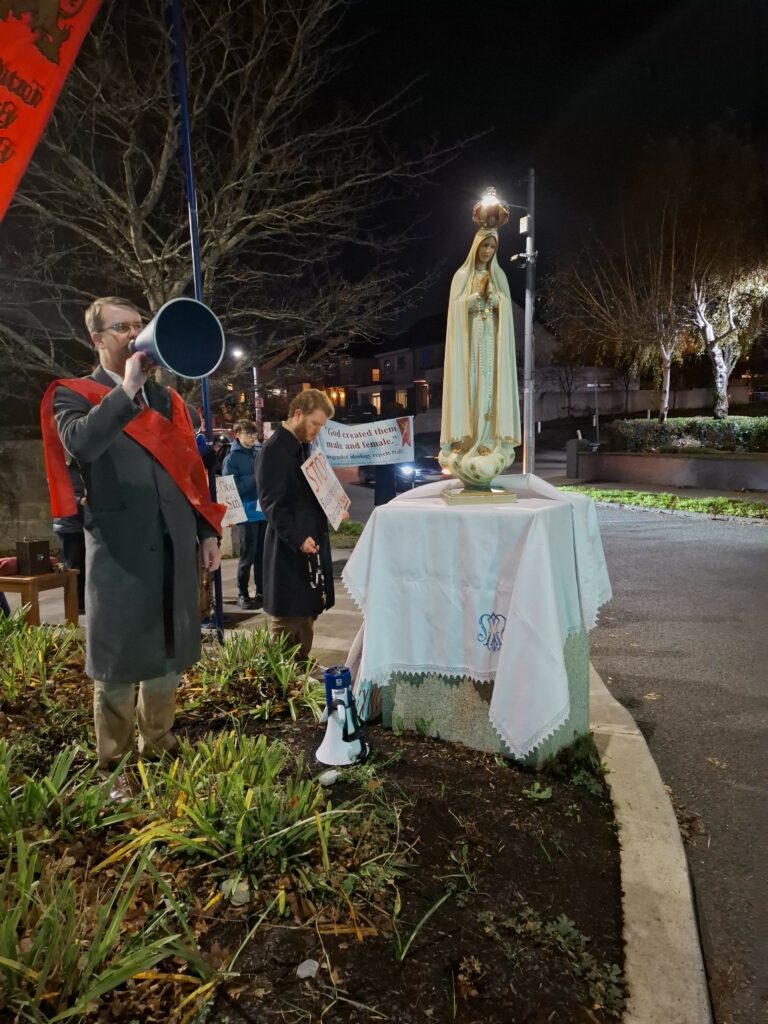In 2014, and again in 2018 when Pope Francis visited Ireland, allegations were widely published of the supposed dumping of babies’ remains in a septic tank at the old Tuam Children’s Home. Headlines across the world blared:
“Bodies of 800 babies, long-dead, found in septic tank at former Irish home for unwed mothers”
– The Washington Post, USA
“Almost 800 ‘forgotten’ Irish children dumped in septic tank mass grave at Catholic home”
– ABC News, Australia.
“Zappone confirms she told pope about children’s bodies in sewage system of Tuam Home”
– The Journal, Ireland
The Bon Secours sisters who had run Tuam Children’s Home from 1925 to 1961 were accused of callously dumping the remains of babies in a septic tank without any proper burial. How true is this? What do the facts actually tell us?
It is essential today for Catholics to know current affairs such as the Tuam scandal in order to effectively defend the honour of the Catholic Church. This does not mean we deny the existence of bad priests, bishops, and nuns in the Catholic Church; It means knowing the entire picture.
The High Mortality Rate
In 1938, the national infant mortality rate for newborns (those less than one year) was 66 per 1,000. The average infant mortality rate in the Tuam Children’s Home from 1924 to 1960 was 128 – over double the national average. This number is more similar to Dublin Borough and Cork City where the rate was 102 and 103 respectively. Several facts, however, make the Home’s statistics inaccurate and actually quite impossible to ascertain.
Many times, children who were brought to the Home by government inspectors came from awful sanitary conditions where diseases were more prevalent. In the 1949 Report, the inspector says this:
“First there is the constant risk of infection brought in from outside by the admission of whole families of itinerants, destitutes, evicted persons, etc.”[1] The chances these unfortunate people had infectious diseases was higher than average because of their often heartbreaking state of life.
The nuns also had to contend with a crowded Home where highly infectious diseases spread rapidly. Many diseases that are today regarded as a nuisance such as measles or Whooping cough killed many babies. In 1926 for example, 64% of deaths were attributed to measles, in 1936 it was 48%. In response to these outbreaks of infectious diseases, the nuns frequently asked for isolation chambers to be built. [2] [3] [4][5]
The statistics mentioned earlier are based upon the death register. While this register was supposed to kept throughout the country, in rural areas it was very patchy. The Home however had a resident doctor and a Medical Officer. This meant that while the birth and death of a baby in a country cottage very likely would never be registered, the birth and death of a baby in the Home would be registered since the competent officers were always present. This obviously gave a higher infant mortality rate to the Home and would partly explain why the rate of the Home and the cities of Dublin and Cork are similar. Both of these cities had a natural concentration of personnel authourised to register a death.
Dumping of Dead Babies in a Septic Tank
In 1975, Frannie Hopkins and Barry Sweeney, two local boys, lifted a concrete lid and discovered a type of vault with bones scattered at the bottom. In 2007, the exact location of the 1975 discovery was recorded by the Archaeological Survey and numbered XXX GA-043-141—.[6] Philip Boucher Hayes also interviewed Frannie Hopkins and photographed him standing over the location of the grave. Both the photograph and the location marked by the Archaeological Survey are within the old workhouse walls while the sewage tank is clearly marked as being outside the walls.

A is where a recent archaeological dig has discovered Famine remains.
B and C are where in 1975 Frannie Hopkins and Barry Sweeney made their discovery.
D is the centre of an area marked as a ‘sewage tank’ in c.1930 O.S. map.
E is the location of a crypt seen by Mary Moriarty.
F is the location of a shed, which during its construction, human remains were found.
Towards the end of 2016, test excavations were done which revealed two structures. According to the commission:
“One structure appears to be a large sewage containment system or septic tank that had been decommissioned and filled with rubble and debris and then covered with top soil. The second structure is a long structure which is divided into 20 chambers. The Commission has not yet determined what the purpose of this structure was but it appears to be related to the treatment/containment of sewage and/or waste water. The Commission has also not yet determined if it was ever used for this purpose.”[7]
Interview of Mary Moriarty
In the 1970’s a girl called Mary Moriarty fell through a hole and discovered what she described as a crypt. “There seemed to be raises, or steps or something, on the far wall opposite me and the babies were placed on that. You could see they were swaddled up, rolled up in cloth, and placed one after another in each raise. And there was quite a lot of them there … I understood it was a crypt.”
…
What I saw seemed to have been newborn babies. Like I couldn’t tell if they were babies or not but the way they were wrapped they seemed to me they were.”
“You made the presumption they were stillborn babies?”
“Yes, that’s what I thought and that’s what the people who were along with me at the time thought as well.
…
There was three or four I thought, levels, or five maybe, from the ground up to the roof that was filled with those parcels, They were like little parcels on the shelves.”
…
“Approximately a hundred bodies?”
“That’s what I presumed was in it. I never realised it was anything more.”[8]
Conclusion
Did the Bon Secours nuns commit a crime? Reading the papers one would certainly think so but according to the Gardai, nothing criminal was committed. “If the coroner suspects suspicious elements then we have an obligation to investigate. We don’t have anything to investigate at the moment because there’s no crime and even if there was, there’s no one to prosecute.”[9] Did the nuns do something morally wrong? Were they disrespectful towards the dead? If its true that the nuns discarded dead babies in a sewage tank then yes, they committed a morally objectionable act. But there is no evidence to support this assertion. The Tuam scandal is far more nuanced than what than what RTE and the Irish Times portray. Catholics should not hang their head in shame every time Tuam is mentioned. They should immediately be suspicious of how the story is being spun and see if they can unearth facts the media try to hide. Most importantly, Catholics should remember that despite the real scandals in the church, such as the presence of active homosexual clergy, the Church has gone through previous crises. And like those previous conflicts, she will emerge victorious over her external and internal enemies.

Much of the content of this article is drawn from @tuambabies: A Critical Look at the Tuam Children’s Home Scandalhttp://www.lulu.com/shop/brian-nugent/tuambabies/paperback/product-23587358.html
Footnotes
1 https://books.google.ie/books/about/tuambabies.html?id=0B9xCQAAQBAJ
2 “The care given to infants in the Home is good; the Sisters are careful and attentive; diets are excellent. It is not here that we must look for cause of the death rate” https://en.wikipedia.org/wiki/Bon_Secours_Mother_and_Baby_Home#Workhouse_and_military_barracks
3 A 1949 report: “They found everything in the Home in very good order, and congratulated the Bon Secours Sisters on the excellent condition of their Institution.” – Tuam Herald 25/06/1949
4 “The committee congratulated Rev Mother Hortense and the Bon Secours community on the very efficient manner in which the Home is being conducted.” – Tuam Herald 29/4/1950
5 “Dr. T B Costello, Medical Officer, Children’s Home, Tuam, and the matron (Sister Hortense), in their respective reports, urged the necessity of proceeding with the erection of the proposed laundry and disinfecting chamber for the Tuam Home owing to the risk of an outbreak of fever in the institution. [and the board did decide to prepare plans for it.]” – Connaught Tribune 23/4/1938
6 Incidentally, the National Monuments Service silently moved the dot a few days after the controversy broke. They moved it from OSI Irish Transverse Mercator coordinates of 544090, 751193 to 544086, 751185. The author of @tuambabies: A Critical Look at the Tuam Children’s Home Scandal, Brian Nugent recorded the exact location a few days before they moved it and also noticed that they retained the townland corresponding to the old location, Toberjarlth, which is now inaccurate when applied to the new one, which is clearly in Farrannabox. The original location was also recorded by Steve White @lostexpectation on twitter before it was moved.
8 Interview by Philip Boucher-Hayes, Drivetime, RTE Radio 1, 12/6/14, https://www.rte.ie/radio/utils/radioplayer/rteradioweb.html#!rii=b9_20597601_83_12-06-20149 https://www.irishexaminer.com/breakingnews/ireland/tuam-no-evidence-of-crime-nobody-to-prosecute-780150.html
Subscribe to our newsletter!
This year, it is more crucial than ever that we turn to prayer and intercession to increase devotion to Our Lady across our country. That’s why you’re invited to join us in the Three Hail Marys Pledge, a powerful devotion that can bring personal spiritual benefits and national transformation. By reciting three Hail Marys daily, you honour the Immaculate Heart of Mary and seek her intercession for the conversion of sinners, the salvation of souls and the restoration of Ireland’s Catholic Faith. This ancient devotion, revealed to Saint Mechtilde, promises spiritual benefits including protection from mortal sin and the assurance of a good death. Your daily prayers will contribute to an increase in devotion to Our Lady, the conversion of sinners and the moral renewal of our country. Let us commit to this powerful devotion and seek the guidance and protection of Our Lady.







